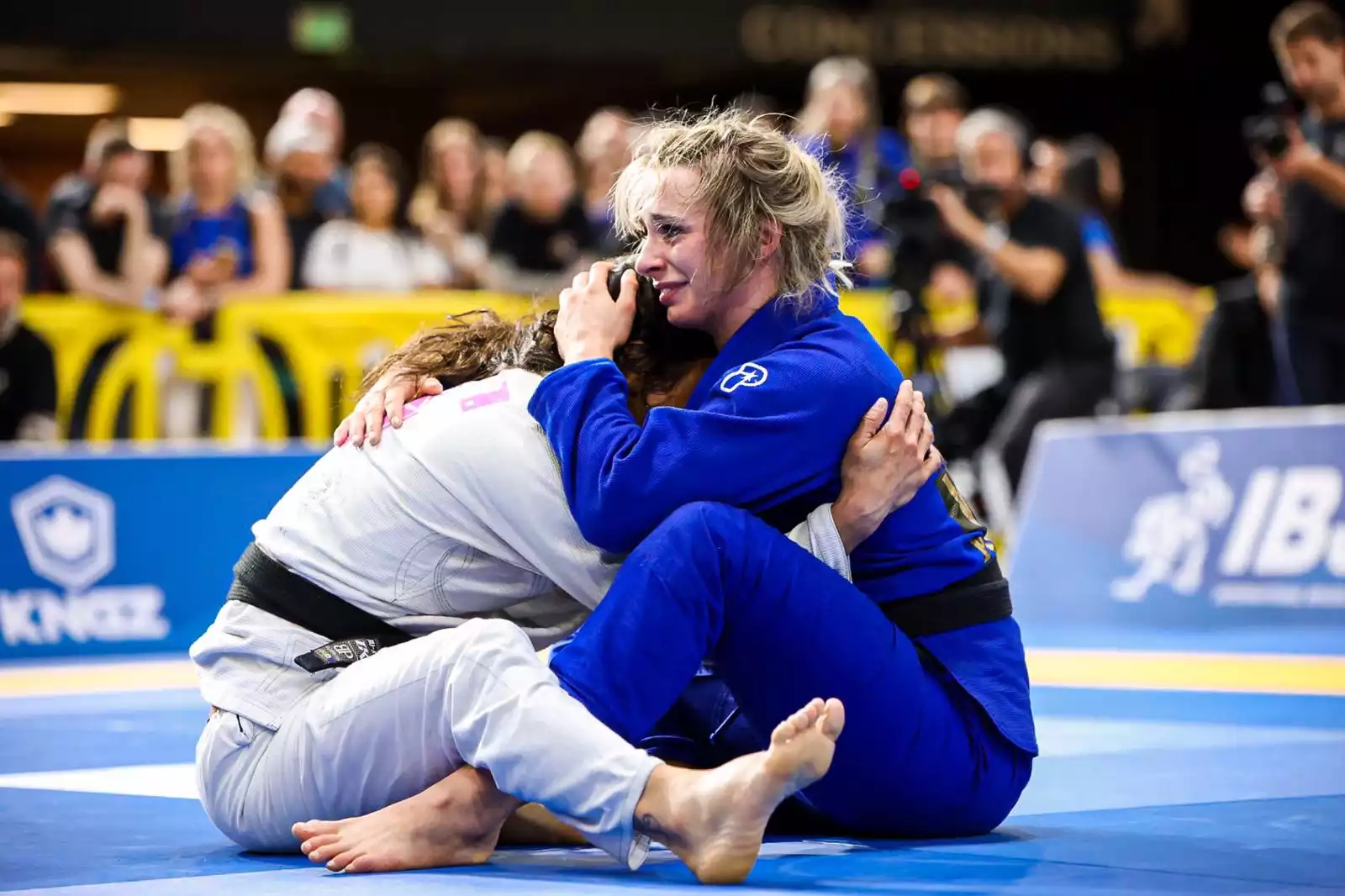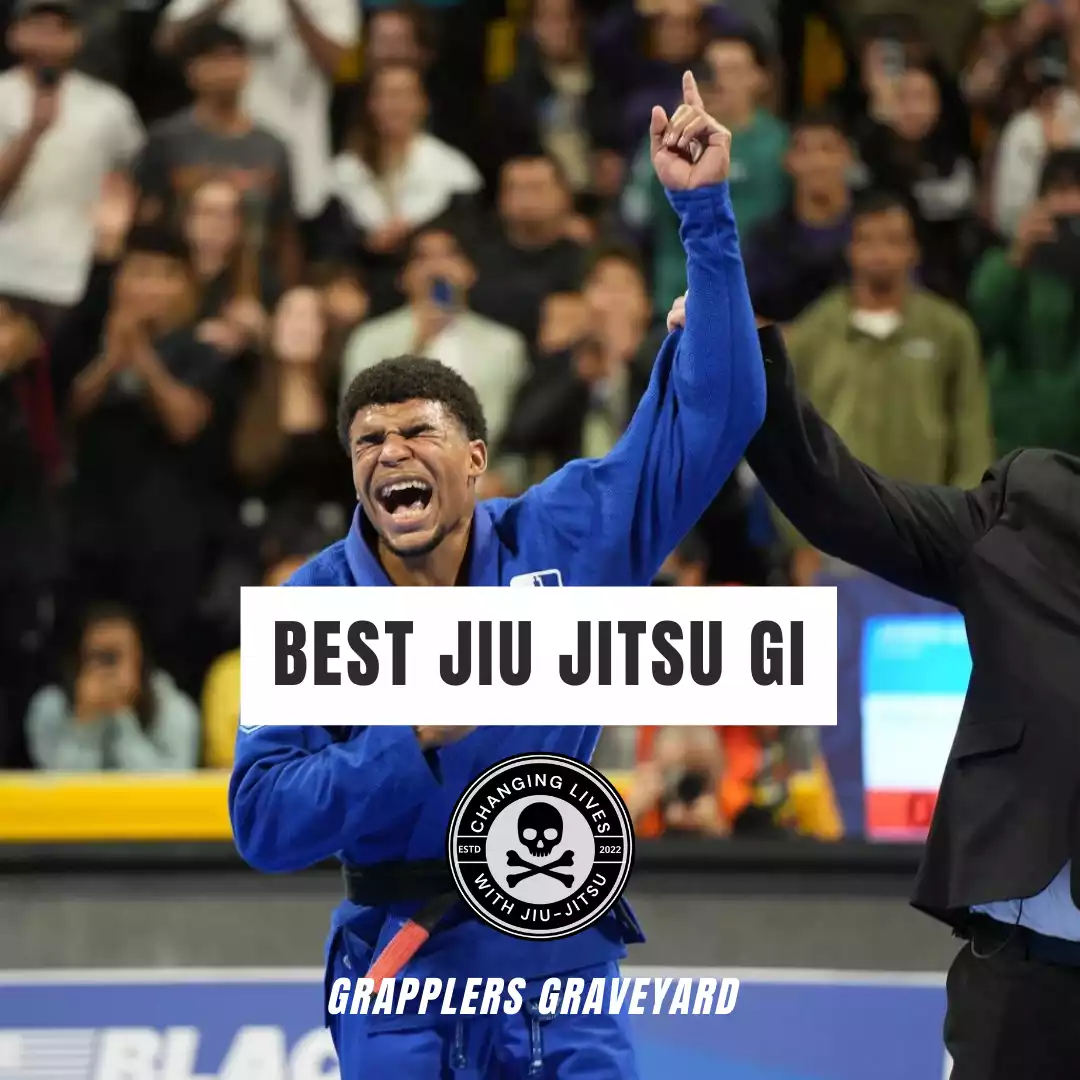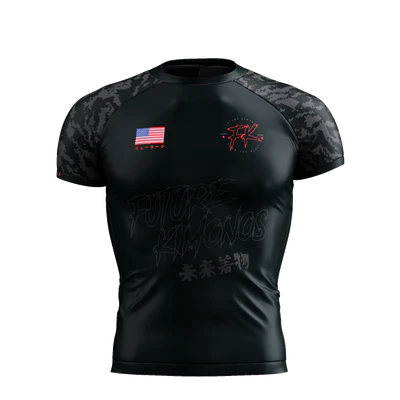Table of Contents
grapplersgraveyard
So you have decided to turn yourself into an unbreakable human being who can problem-solve their way through life? Perfect! In this article, you will be red-pilled on the great martial art known as Brazilian jiu-jitsu. Here we will discuss where it originated, and why everyone uses it as a self-defense tool!

WHAT IS BRAZILIAN JIU-JITSU?
Brazilian Jiu-Jitsu is a ground-based martial art, that uses leverage, angles, pressure, timing, and knowledge of the human anatomy to achieve a non-violent submission of one’s opponent.
Unlike other martial arts that focus on strikes and/or kicks, its main focus is on close-contact “grappling” holds and techniques, and the application of chokes and joint manipulations.
QUICK HISTORY OF BRAZILIAN JIU JITSU
The Brazilian style of jiu-jitsu resulted from the import of Japanese jiu-jitsu and judo to the South American continent in the early 1900s. Its origins trace back to Japan and morphed into what it is today by the early Brazilian pioneers.

The martial art is believed to go back thousands of years. There are several theories on its very first beginnings, but many agree that it can at least be traced back 4,000 years ago, to Buddhist monks in India, who needed to protect themselves during their travels without inflicting harm on their attackers.
In 1915, a world-famous Japanese judoka, Mitsuyo Maeda, arrived in Brazil, where he soon began teaching and giving demonstrations in jiu-jitsu and judo. Three of Maeda’s first students went on to become the founders of what is known as Brazilian Jiu-Jitsu: brothers Carlos and Helio Gracie, and Luiz França. Each of these early pioneers contributed to the development of what is today known as Brazilian jiu-jitsu(BJJ), by maximizing the effectiveness of existing techniques, creating new ones, and giving rise to a distinct martial art.
It wasn’t long before the Brazilian style of jiu-jitsu started to spread to other countries and continents. BJJ arrived in the United States in the early 1970s but grew relatively slowly until the 1990s when the UFC brought mixed martial arts – and Brazilian Jiu-Jitsu – to the mainstream public. In 2002, Carlos Gracie, Jr. founded the International Brazilian Jiu-Jitsu Federation, which began holding organized jiu-jitsu competitions worldwide. In the last decade, the sport has boomed, and today, many of the world’s largest and most prestigious tournaments are held in the United States.
All BJJ practitioners can trace their “lineage” back to one of the founding members. Professor JT’s lineage can be traced back to Carlos and Helio Gracie. Jiu-jitsu masters like Carlos Gracie, Helio Gracie, and Renzo Gracie have truly created a movement that may impact the world for years to come. The Gracie family lineage and legacy are strong in the United States. Gracie Jiu-Jitsu Academys can be found in most parts of the United States today!
WHY SHOULD YOU TRAIN TODAY?
We have written many articles on the benefits of training jiu-jitsu at this point, but if you have not read them you can find them here (source). BJJ is more than just a workout. Brazilian Jiu-Jitsu is often referred to as “human chess” in that it exercises both the body and the mind.

What are the benefits of doing BJJ?
Self Defense
There is no martial art that exists (maybe outside of boxing) that will prepare you for a real-world situation like Brazilian Jiu-Jitsu. Everyone has a different reason why they originally get into the sport but many do get into it for self-defense. We originally got the interest because we found ourselves in a physical altercation that we ended up feeling completely out of control of. It was a horrible situation to find ourselves in and vowed that we would never feel that way again.
Exercise
Working out at the gym is just boring these days. We will stand on this mountain and scream it till our lungs fall out. You drink candy-flavored pre-workouts and go through the motions just to look nice (which is not a bad thing because you will look just as good doing jiu-jitsu).
We were lifting weights and getting very strong before we started Brazilian Jiu-Jitsu and one incident proved that no matter how much I lifted if a fight broke out I was unprepared. What’s the point of getting “swoll” if you cannot protect yourself or your family if there is the danger?
Mental Game
The part that makes jiu-jitsu most addicting is the mental aspect of the sport. It is human chess and until you experience it first hand you will not know how fun it is to roll around
The sport is an art form so there is always something to be learned. After the first couple of months of getting beat up, you start to see yourself progress and get better. You learn very quickly what to do and what not to do when you start applying the techniques learned in fundamentals class to the intermediate live rolls!
How is Jiu-Jitsu different from other martial arts?
Depending on the martial art you are comparing Brazilian jiu-jitsu to, you can find some massive differences in the way the martial art is performed. The underlying focus of Brazilian jiu-jitsu is to successfully defend against an aggressor regardless of big or small you or your opponent is. It is a martial art that involves dynamic and explosive movements to get a dominant position over an opponent. Time and time again, Brazilian jiu-jitsu has been proven to be an excellent martial art for self defense in street fights and produced has gone on to be the backbone of most UFC champions fighting styles.
Not many martial arts in the scene have this type of street cred.
Brazilian jiu-jitsu is a grappling-based martial art like its counterparts wrestling and judo. Those two grappling styles closely replicate what is going on in jiu-jitsu but have obvious differences. We strongly believe that grappling martial arts make for an incredible mental workout and are excellent for physical conditioning, and physical fitness.
When you start comparing Brazilian jiu-jitsu to martial arts like boxing, muay Thai, karate, or even krav maga, you start to get into a territory where the argument doesn’t even make sense. Striking martial arts like these rarely focus on ground fighting like grappling-based martial arts.
Is Jiu-Jitsu like Mixed Martial Arts (MMA)?
No, it is not. In MMA you have striking involved and in BJJ strikes are not prohibited. Mixed martial artists train and are proficient in Brazilian jiu-jitsu ten out of ten times because BJJ has been proven to be an important art to learn if you want to be a fighter. Learning jiu-jitsu is an integral part of being a fighter in today’s meta, you really cannot get to the highest level (or even get a shot at fighting in the UFC) without ample experience, you would end up getting mauled.
Discover the world of Brazilian-Jiu Jitsu: a holistic martial art, a sport, an approach to life.
Grappling Sports
Brazilian jiu-jitsu is just one of many grappling-based martial arts that is practiced around the world. There are many different fighting styles that teach a whole new set of techniques. The two most popular grappling sports outside of Brazilian jiu-jitsu are wrestling and judo.
Judo is a grappling martial art based on throws and submissions. We have written articles about Judo and its differences (and similarities) to both BJJ and Wrestling.
Wrestling is probably by far one of the hardest sports in the world. Just spend time in wrestling practice and you will understand. If you have aspirations to become a top-notch fighter in the UFC, chances are you are going to have to master on of these three styles.
What is Jiu-Jitsu good for?
Brazilian jiu-jitsu is a martial art that was created for a smaller trained opponent can take on a much larger opponent in a self-defense scenario. Brazilian jiu-jitsu is a martial art that is best known for teaching practitioners excellent ways to execute ground fighting. majority of Brazilian jiu-jitsu is done either on your back or from a standing position, at some point in a fight you may end up on the ground (90% of the time) and that is when Brazilian jiu-jitsu is going to be most useful.
Outside of teaching you how to be a badass on the ground jiu-jitsu has a number of unspoken benefits for people outside of just getting into excellent shape. Your resilience, ability to handle pressure, discipline, and ability to do hard things will all be tested. For many people, this is a great way to completely change the framework of who you are.
The human body can do some amazing things and you truly haven’t lived till you figured out what yours is truly capable of. Close combat is a great way to get yourself out of your comfort zone.
Is Jiu-Jitsu hard for beginners?
The first 6 months of training jiu-jitsu are a true test for your mental fortitude. In this time you will figure out what you are made of and if you want to continue doing the gentle art known as Brazilian jiu-jitsu. It may not be a thing for everyone and that is okay but by no means is it easy to constantly put yourself in a situation to fail and have to get yourself back up to try all over again.
To answer the question in a similar way, jiu-jitsu is not easy for beginners. If you come in with some type of athletic background like you maybe wrestled or played some sports as a kid you may have an easier time learning moves in the beginning. If you do not have that type of experience you will have to build from the ground up.
It should be noted that Brazilian jiu-jitsu “shape” is not something you will walk in having.
This is a common excuse many people will use to stop themselves from jumping in. “Once I get into shape I will go and check it out” is the easiest cope out someone can say. The only way you can be in shape for jiu-jitsu is by getting on the mats and rolling with people, running may help but no one walks in 100% prepared.
Find the top-rated BJJ Gi's here. Helpful information on what to look for, how to find the best gi, and which brands suit you best based on your budget!
THE DIFFERENT STYLES OF BJJ
In Brazilian jiu-jitsu, there are two main styles of play that people will get used to, Gi and No-gi. No-gi grappling has been taking the world by storm and has been the main driver in the current meta in the jiu-jitsu community. With no-gi jiu-jitsu, the matches are completed in just regular rash guards and fighting shorts but while training in Gi you will wear a full kimono.
A new up-and-coming trend in the jiu-jitsu world is combat jiu-jitsu. CJJ is regular jiu-jitsu with open-hand striking. We wrote an extensive article on what exactly CJJ is and the ruleset within that style of play (source).
BJJ BELT RANKS
Just like many other martial arts outside of Boxing and Muay Thai, Brazilian jiu-jitsu has a belt system in place that ranks its practitioners based on skill and how long they have been training. In Brazilian jiu-jitsu there are 5 belts that one person can achieve, they are:
White Belt – First belt and typically take 12 – 24 months to move to the next belt
Blue Belt – The belt you will spend the most time at
Purple Belt – The belt is known as your first sign of expertise
Brown Belt – You are a black belt but not really
Black Belt – The highest rank one will receive in (BJJ typically takes 7 – 10 years to get here)
It is known that as a white belt, you are learning just the basic principles of martial art. 90% of people that start at this belt will quit before they get to their blue belt and then the curve drops even more with about 75% of blue belts quitting before they get their purple belt.
As time goes on, BJJ weeds out most people, and the ones that are left are typically the colored belts in your gym. there is something to be learned about the mindset that it takes to progress in Brazilian jiu-jitsu and stick around for the long term. This is why people with higher-ranking belts get respect in the gym, they have proven themselves as a valuable member of this community.
WHAT ARE THE YOUTH BELT RANKS FOR BRAZILIAN JIU-JITSU?
The belt ranking for the youth is a bit different than for the adult. Again, we wrote an extensive article on the belt system that is in place for kids (under 16 years of age) that you can find in our catalog of blog posts (source).
THE STRIPES AND DEGREES ON A BRAZILIAN JIU-JITSU BELT
Since the timeline to progress in Brazilian jiu-jitsu is extremely long, practitioners of the sport get mini-promotions along their way to getting their next belt color. This is known as getting a stripe.
Stripes indicate that you are still showing progress in your skill level but are not quite there yet to receive the next belt in line. To max out a belt you will have four stripes. Note, some people with one or two stripes may jump up to the next belt level depending on how well they progressed since the last promotion, it will all vary and is up to your coaches how they want to move you up.
What do stripes on your Jiu-Jitsu belt signify?
Stripes represent progress toward the next belt rank. Before moving onto the next rank you have to get four stripes within the respective rank that you are currently in. In most cases people do not jump over stripes but it is possible if someone has progressed tremendously since their last promotion.
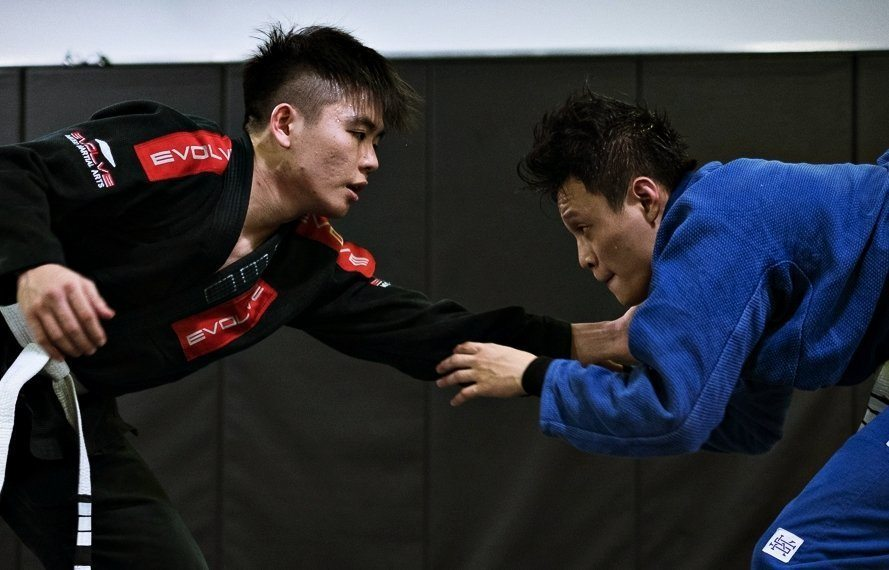
BJJ Belt System
White Belt
As a BJJ white belt, you are learning the most. It is the stage where most of your major fuck-ups will happen. It’s aimed at creating a framework for the future knowledge that you will learn while taking on Brazilian jiu-jitsu. White belts learn basic techniques and do their best to just survive at this stage.
As a white belt, you should just be a sponge for knowledge. The majority of your time and effort will be spent on learning techniques and learning how to get out of bad positions you find yourself in while rolling.
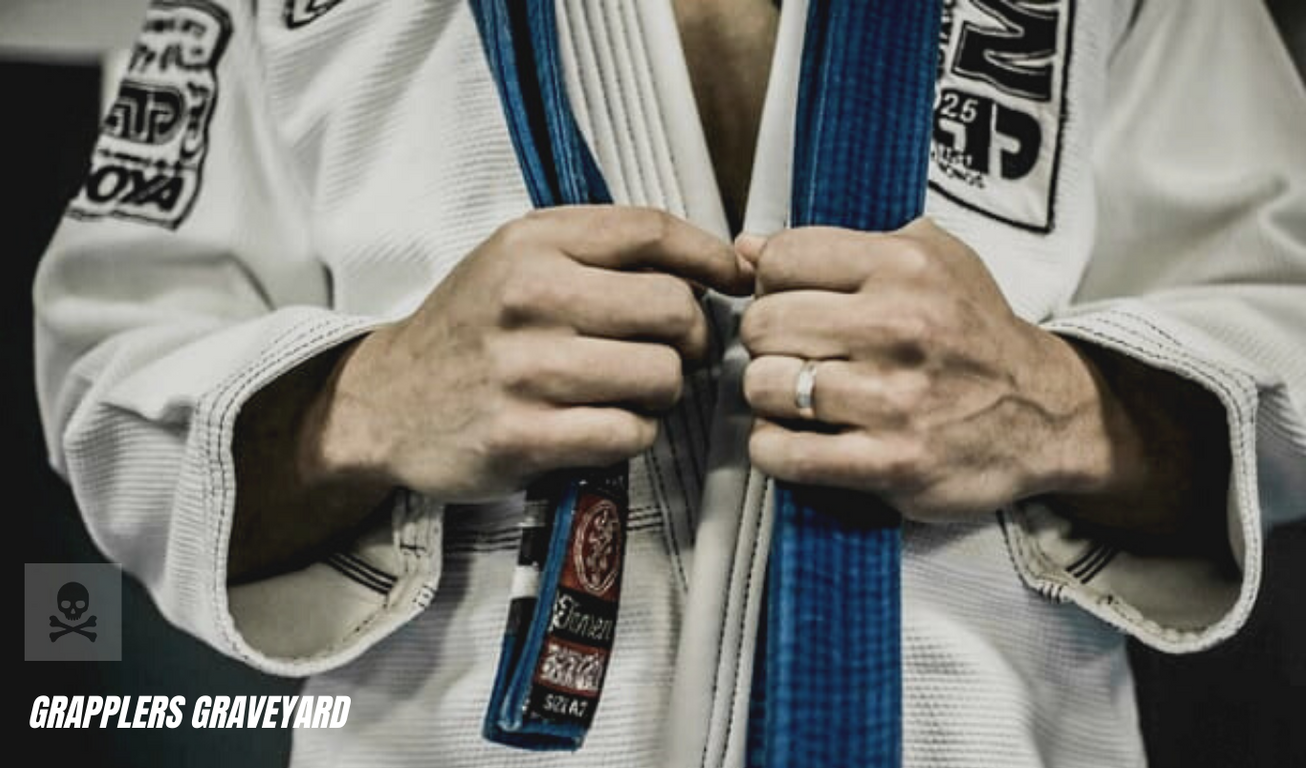
Blue Belt
Students at the Blue Belt level will have a strong idea of how they should attack. A student with the coveted blue belt can use good defensive tactics and can escape major positions with ease in most cases.
At this stage, you would still be considered a beginner in some respect but chances are you’re still making fundamental errors, but you’re keeping enough knowledge to take the right steps. As the blue belt, you realize skills are missing or crucial techniques that need cleaning up. When a blue belt is achieved, the ability to increase independence and confidence will grow.
The blue belt in Brazilian jiu-jitsu is the belt that you will spend the majority of your time at. At a minimum expect 2 years as a blue belt but in some cases, the grind up to a purple belt can take an added 4 more years. Getting to the Purple belt is a serious accomplishment because by this time majority of people have given up on getting to this point.
Athletes over the age f 16 years old can receive this belt. If an athlete is under 16 they will just progress within the realm of the kids ranking system.
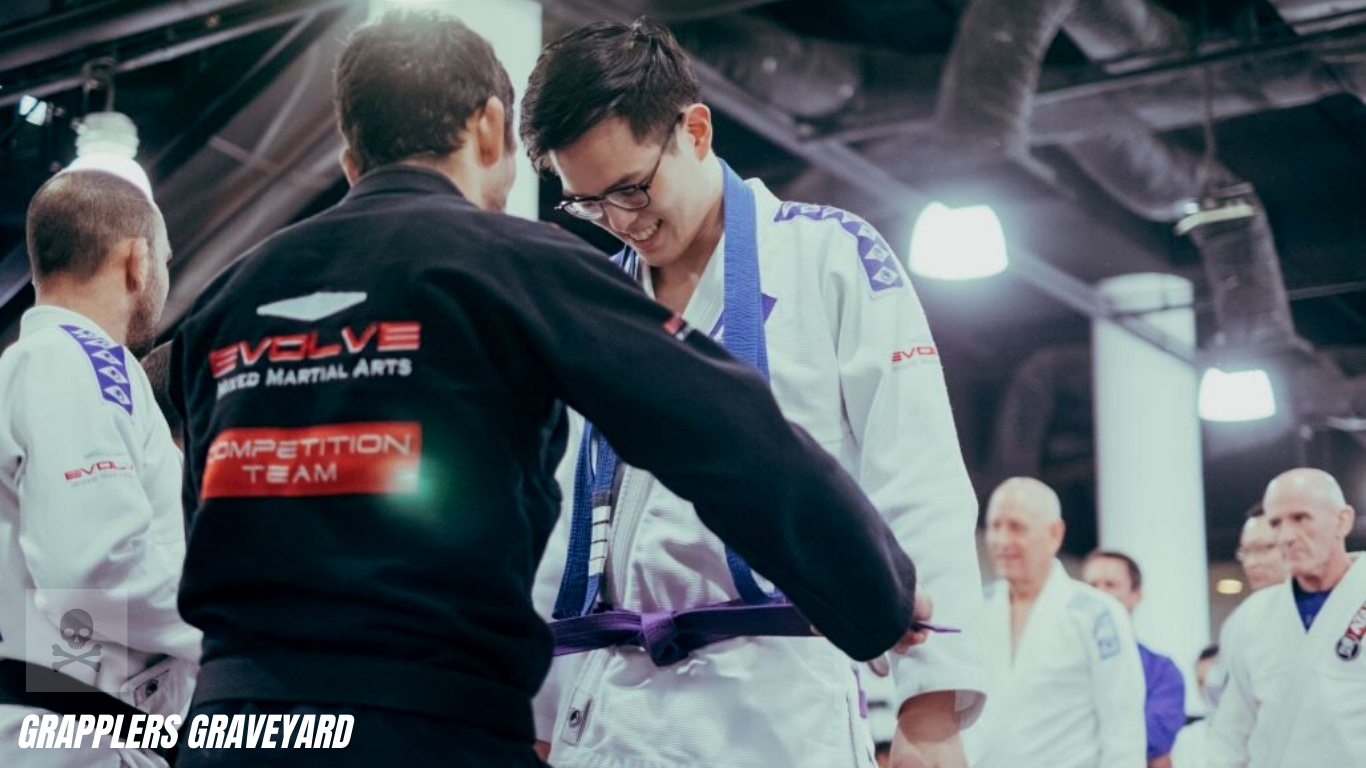
Purple Belt
The purple belt is the stage at which you start to show real competence. Most people will tell you it is a sign that you are on your way to mastering this martial art. By this time, you have spent at least 6 years training and brand-new white belts will look at you for guidance.
If you make it here, your path to getting to the black belt is clear as day. You’re right around the corner from the biggest accomplishment you can get within this martial art. Do not give up and be sure to take care of your body so you do not have any major setbacks along the way.
The youngest you can be to possess this belt is 18 years old.
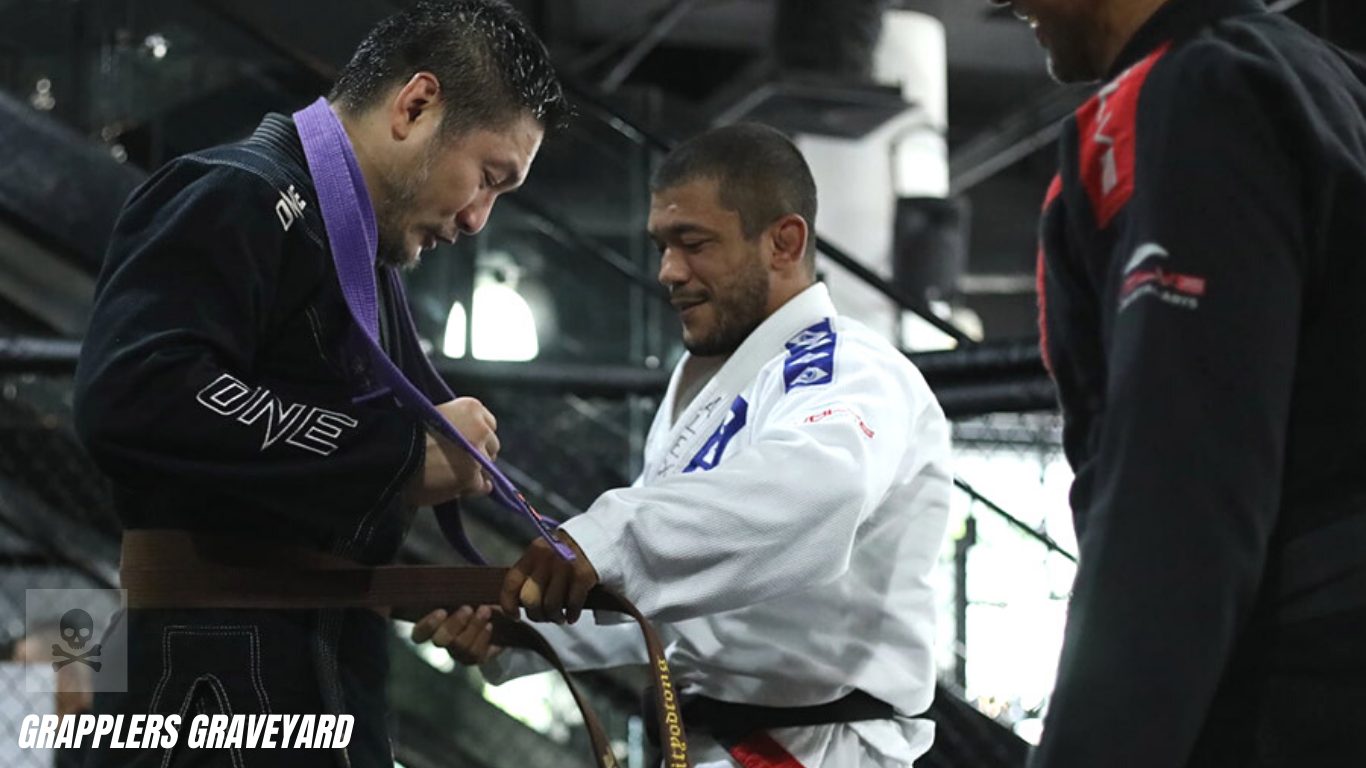
Brown Belts
Currently, the IBJJF requires practitioners to spend twelve months with a purple belt before they can get promoted to a brown belt. You can check the timeline for the belt system on their website (source). The youngest you can be to possess this belt is 18 years old.
Competing with a brown belt can be intimidating because this position is one in which IBFJJF allows movements such as hooks, reaps, or knee bars.
Black Belt
The black belt is the last stage of the Jiu-jitsu ranking system. At this stage you are considered a master of your craft in many ways but may not feel like it at times. Even when you reach this stage there are still many things to look forward to.
Chances are, if you make it here, you have shown to those around you the type of person you are. We have spoken to many black belts and they tell us the world opened up to them when they got this rank. They pass on wisdom to lower belts (like ourselves) saying things like belts do not matter, what matters is that you proved that you could show up for yourself and completely change who you are as a human.
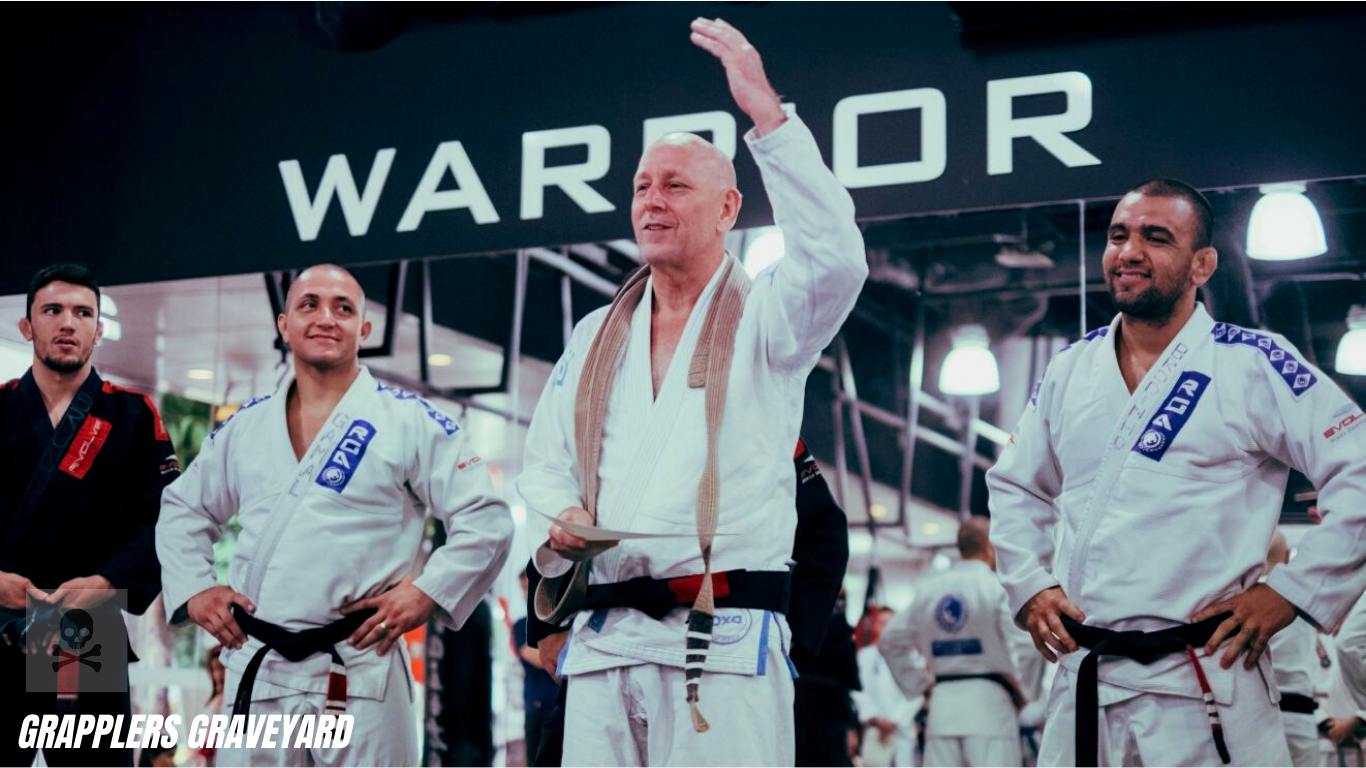
Find top-rated rash guards here
THE TRAINING OF BJJ
Combat sports are not easy and will require a different type of conditioning. Most people that train do not come to the gym in “jiu-jitsu shape” this is something that develops over time. You will notice the physical benefits that everyone talks about kicking in at about 6 – 8 months in if you stay consistent with your training and take your nutrition seriously.
THE COMPETITION OF BRAZILIAN JIU JITSU
The competitive scene in BJJ is a good sign that martial art is appealing to the masses. The number of jiu-jitsu tournament organizers that provide a safe and exciting experience for jiu-jitsu practitioners around the world is a sight to see alone. The biggest tournaments are hosted by IBJJF, ADCC, Jiu-Jitsu World League, F2W (Fight to Win), and NAGA. Outside of those four, you will typically find more local(but still very large) tournaments like the ones hosted by AZBJJL.
IS BRAZILIAN JIU-JITSU THE STRONGEST MARTIAL ART?
What makes a martial art the strongest may be a better question to start with here.
The criteria I would look at to deem a martial art “top-tier” is going to be a list of things.
Has martial art been proven to be effective for self-defense?
Do I get live matches that mimic a situation where I would have to use my skills?
What are the best fighters in the world learning and applying?
I think when you approach it by asking the above questions you conclude that grappling martial arts, in general, are the most superior of any martial art closely followed by boxing and kickboxing. Look at the past champions in the UFC and tell me what you see.
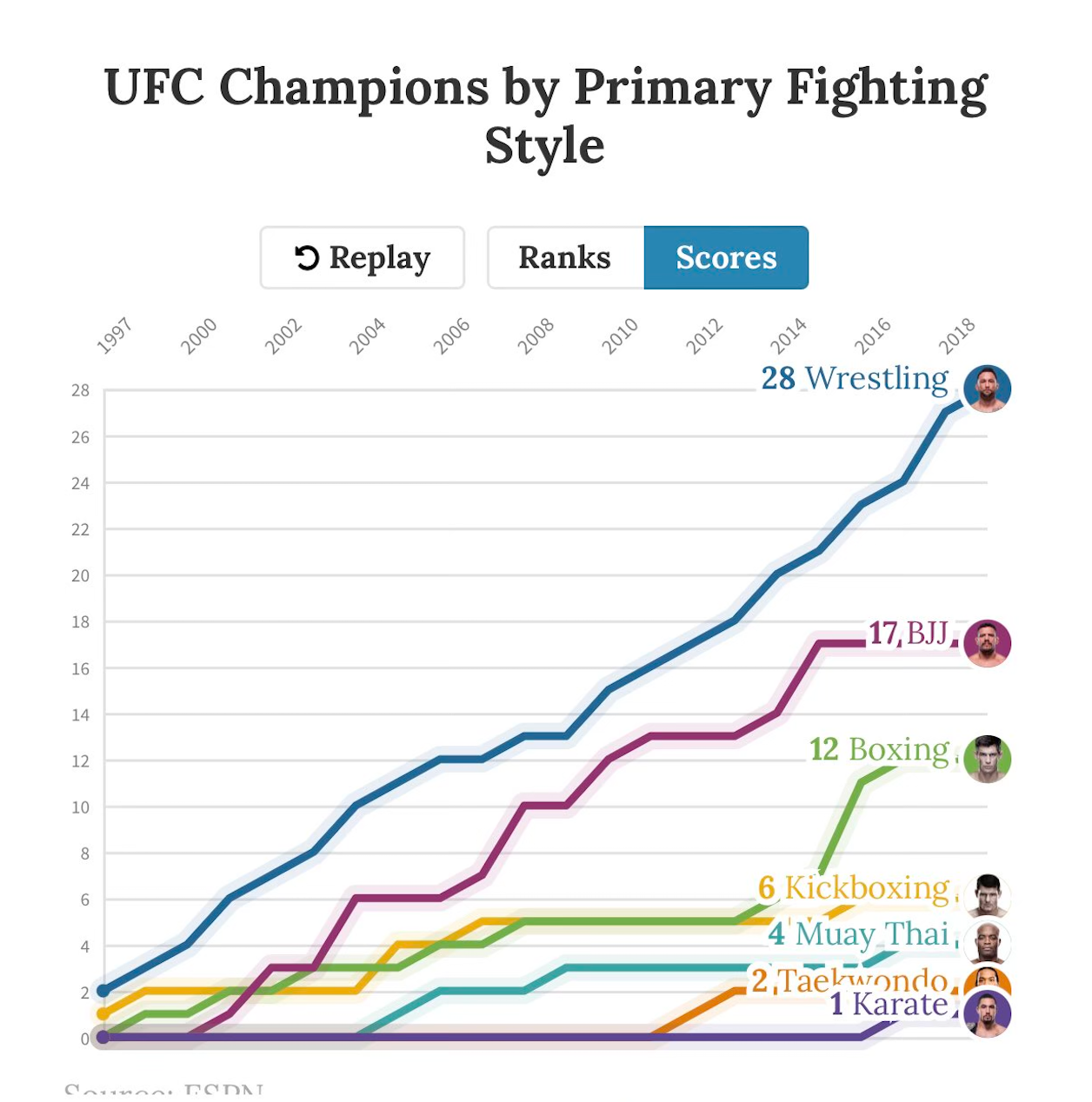
WHAT KIND OF WORKOUT IS BJJ?
Jiu-jitsu forces you to push yourself in new ways many people are not used to. Going to the gym is not like rolling live against an opponent that is actively trying to choke you out. Brazilian jiu-jitsu is both a mental and physical workout that incorporates building strength and better cardio.
HOW LONG DOES IT TAKE TO GET A BJJ BLACK BELT?
In most cases, it will take someone about a decade to get their black belt.
If patience and grinding over long periods are not your thing you will have to reconsider if Brazilian jiu-jitsu is the martial art that you want to take on. If you want something fast and easy, check out your local karate studio.
BJJ focuses on recreating the individual that takes learning jiu-jitsu seriously. By the time you reach your black belt, you will be a completely different human. Every black belt we have met has been very successful in whatever endeavor they have chosen in their life because of the principles they learned on the mats. If you are someone who wants to be a leader and wants a life they are proud of, chasing after your black belt will be a fruitful experience for you.
Discover the world of Brazilian-Jiu Jitsu: a holistic martial art, a sport, an approach to life.
THE GRAPPLERS GRAVEYARD
We look at martial arts as one of the greatest tools to improve your life. Physically, mentally, and emotionally we have become stronger humans and have a burning desire to help people get into the sport.
The Grapplers Graveyard is helping forge exceptional humans with martial arts. We help martial artists become exceptional humans and athletes. We empower you to stand out from your peers by becoming extraordinary humans!
Strong men and women chose to level up their lives in many different ways but nothing will impact you more than BJJ.
Brazilian jiu-jitsu is a martial art that we believe can impact millions of more people across the world. We want to share what we have learned along the way and help guide those with the lessons and principles that we have learned while training on the mats.
Good Luck & Happy Rolling!


